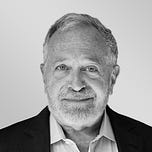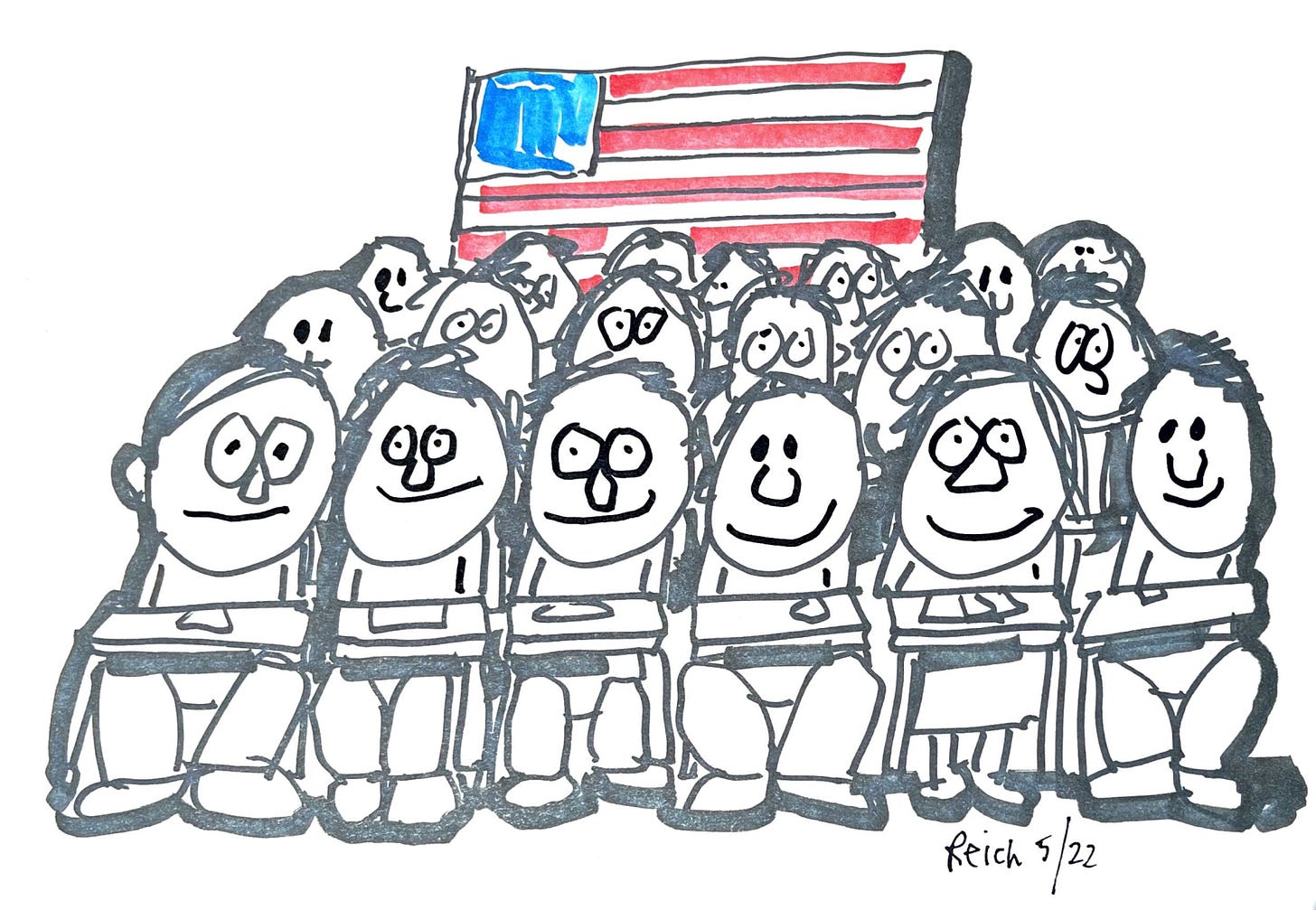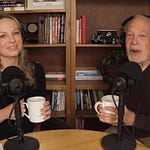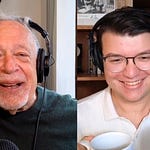I think about those 19 children who were murdered in their classroom on Tuesday, and feel the need to go back to basics — to the common good. Given the the difficulty of enacting sensible laws to reduce gun violence — which reflects in part the deepening split between Americans who believe in democracy and those who are throwing in their lot with Trump authoritarians — the question I keep coming back to is: what can we can do to rekindle a sense of common good?
One of the most important initiatives would be to restart civic education in our schools.
I know, I know: Public schools are under attack from the right. Political battles have left school boards, educators, and students in the crosshairs of culture warriors. Which is why, paradoxically, this might be exactly the right time to push for civic education.
If you’re as old as I am, you may remember courses in civic education. They were required in most high schools during the 1950s and early 1960s. Mine weren’t terribly inspiring (my teacher in 9th grade civics was so obsessed by the “menace of communism,” as she called it, that she repeatedly showed us maps on which the U.S.S.R. and China — covering most of the land mass of Eastern Europe and Asia — were colored bright red, and she warned that the rest of the world was next). But merely having a time and place to consider the duties of citizenship was itself useful and important.
Three decades later, after the Vietnam War had torn the nation apart, most high school courses in civic education were abandoned in favor of curricula emphasizing the skills necessary to “get ahead.” When I was secretary of labor, Bill Clinton and I often appeared at schools and community colleges, telling students that “what you earn depends on what you learn.” It was a catchy phrase designed to convince young people they should stay in school so they could get higher wages afterward.
Today, most people view education as a personal (or family) investment in future earnings. That’s one reason so much of the cost of college is now put on students and their families, and why so many young people graduate with crippling college loans. (When education is seen as a personal investment yielding private returns, there’s no reason why anyone other than the “investor” should pay for it.)
But education is not just a personal investment. It’s a public good. It builds the capacity of the nation to govern itself.
At the close of the Constitutional Convention of 1787, a woman was said to have asked Benjamin Franklin what sort of government the delegates had created for the people. He replied, “A republic, madam, if you can keep it.” Franklin and America’s other founders knew how easily emperors and kings could mislead the public. The survival of the new republic required citizens imbued, in the language of the time, with civic virtue. “Ignorance and despotism seem made for each other,” Jefferson warned. But if the new nation could “enlighten the people generally . . . tyranny and the oppressions of mind and body will vanish, like evil spirits at the dawn of day.”
Some towns during the colonial era ran public grammar schools, but only for a few weeks in the winter when family farms didn’t require their children’s labor. After the Revolution, many reformers advocated free public education as a means to protect democracy. Jedediah Peck of upstate New York typified the reform movement. “In all countries where education is confined to a few people,” he warned, “we always find arbitrary governments and abject slavery.” Peck convinced the New York legislature to create a comprehensive system of public education.
The person most credited with founding American public schooling, Massachusetts educator Horace Mann, directly linked public education to democracy. “A republican form of government, without intelligence in the people,” he wrote, “must be, on a vast scale, what a mad-house, without superintendent or keepers, would be on a small one.” Mann believed it important that public schools educate all children together, “in common.” The mix of ethnicities, races, and social classes in the same schools would help children learn the habits and attitudes of citizenship. The goal extended through higher education as well. Charles W. Eliot, who became president of Harvard in 1869, believed “the best solution to the problem of national order lay in the education of individuals to the ideals of service, stewardship, and cooperation.”
If the common good is ever to be restored in America, education must ground people in responsible citizenship. This requires that schools focus not just on building personal skills but also on inculcating civic obligations.
I see such a curriculum as having six elements:
1. For starters, every child should gain an understanding of our political system, the Constitution, the Bill of Rights, separation of powers, checks and balances, and federalism. They must understand the meaning and importance of the rule of law and why no one should be above it. After all, people who want to become naturalized citizens have to pass a civics test covering the organization of the U.S. government and American history. Children born in America should know no less.
2. Every child must also understand the difference between how our system should work and how it actually works, and why we all have an obligation to seek to bridge that gap. They need to see how the economy is organized, how its rules are made, and what groups and interests have the most influence in making those rules. And they must grasp the meaning and importance of justice — of equal political rights and equal economic opportunity, and how these two goals are related.
3. They must learn to be open to new thoughts and ideas, and practice tolerance toward different beliefs, ethnicities, races, and religions. Such an education must equip young people to communicate with others who do not share their views. It should teach them how to listen — opening their minds to the possibility that their own views and preconceptions may be wrong, and discovering why people with opposing views believe what they do.
4. They must be able to find the truth. A civic education should train people to think critically, be skeptical (but not cynical) about what they hear and read, find reliable sources of information, apply basic logic and analysis, and know enough about history and the physical world to differentiate fact from fiction. It should enable them to separate facts and logic from values and beliefs.
5. Such an education must encourage civic virtue. It should explain and illustrate the profound differences between doing whatever it takes to win, and acting for the common good; between getting as much as one can get for oneself, and giving back to society; between seeking personal celebrity, wealth, or power, and helping build a better society for all. And why the latter choices are morally necessary.
6. Finally, civic virtue must be practiced. Two years of required public service would give young people an opportunity to learn civic responsibility by serving the common good directly. It should be a duty of citizenship.
These lessons require learning by doing. Young people need to develop what Tocqueville called the “habits of the heart” by taking on responsibilities in their communities — working in homeless shelters and soup kitchens, tutoring, mentoring, coaching kids’ sports teams, helping the elderly and infirm. Young people must move out of their bubbles of class, race, religion, and ideology, and go to places and engage in activities where people look different from themselves, and have different beliefs and outlooks from their own.
This is how we once regarded military service. From the start of World War II until January 1973, nearly every young man in America faced the prospect of being drafted into the army. True, many children of the rich found means to stay out of harm’s way, but the draft at least spread responsibility and heightened the public’s sensitivity to the human costs of war. Richard Nixon officially ended the draft and created a paid military mainly to take the wind out of the sails of the antiwar movement (and he succeeded). Since then, the United States has had what’s called an “all-volunteer” army— but it’s been “volunteer” only in the sense that young people have taken these jobs because they were among the best they could get. Today’s military has fewer young people from rich families than the population as a whole, more Southerners and a higher percentage of Black Americans.
Two years in the armed services or in some other service to the nation would help instill in all young people a sense of their obligations to society, regardless of their family’s wealth or status. It would allow young Americans to connect with other Americans who differ from them by race, social class, and politics. (Not incidentally, it might also remind many upper-income Americans of the personal costs and risks of American foreign policy.) Public service could take many forms in addition to military service. The Peace Corps could be revived and expanded. Projects like “Teach for America” could be enlarged and extended to other service professions, like “Social Work for America.” Nonprofits could offer a range of public service work. All such recruits would be paid a modest stipend, at least living expenses plus interest payments on any student loans. That would be less than the current pay of “all-volunteer” army recruits.
We owe to one another our time and energies to improve our communities and our nation, and to protect and strengthen our democracy. There’s no guarantee that civic education will heal our wounds or make us more able to enact sensible measures the nation needs — such as reducing gun violence, as well as slowing and reversing climate change, and protecting the right to vote — but I can think of no better way to get to where we need to be.
What do you think?






















Share this post